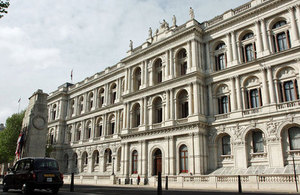Afghan forces to take on security lead for Nad-e Ali
Afghanistan’s own forces will take lead responsibility for delivering security in a number of new areas across the country - including the Nad-e Ali district of Helmand where British forces operate.

The latest phase of the Transition process, announced today by Afghan President Hamid Karzai, demonstrates continuing progress in the development of the Afghan National Security Forces (ANSF)
Training the Afghans to lead on security across the country is now the main effort of International Security Assistance Force (ISAF) troops. Building up the ANSF capability so that they can prevent Al Qaeda from operating freely in Afghanistan and posing a threat to us and to our allies around the world will allow British combat forces to draw down gradually.
Across Afghanistan, today’s announcement means that Afghan Forces will soon have lead responsibility for the security of almost half of the country’s population.
All of Afghanistan will have begun the process of transition by the end of 2013 and the ANSF will be leading on security operations in all provinces by the end of 2014.
The ANSF are getting more capable by the day and are already demonstrating their effectiveness and delivering security in areas included in the first phase of Transition, announced on 20 July 2011, with minimal ISAF support.
These areas include Lashkar Gah, the previously British-controlled capital of Helmand province, where there has been no significant increase in either insurgent or criminal activity as the Afghan National Security Forces have taken on greater responsibility.
British troops have operated in Nad-e Ali since 2006, working to clear the area of insurgent activity and intimidation while building and developing the capability of the Afghan National Army and Afghan National Police. In anticipation of today’s announcement, the Afghans have increasingly led security operations over recent months, with British forces in support. This joint security effort has led to an 86 per cent drop in violent incidents across the district this year compared with 2010.
Secretary of State for Defence, Philip Hammond, said:
“I welcome President Karzai’s announcement that Nad-e Ali will be transferred to Afghan security control.
“This is testament to the increasing capability of the Afghan National Security Forces to deliver their own security in this district, which I visited myself recently, and to the incredible work of the British and allied forces who have trained and partnered them. I pay tribute to them and the great things they have achieved in training, mentoring and partnering their Afghan colleagues.
“There is no doubt that the work and achievements of our Service personnel is making the UK a safer place and protecting our national security.”
The improved security situation has enabled the Afghan Government to reach out to the local people of Nad-e Ali, with trade and commerce levels flourishing and, importantly, the insurgency being denied a safe haven from which to plot and mount attacks.
Transition is a carefully planned, joint process. Decisions are made jointly by the Afghan Government and ISAF. By the end of 2014 Afghan forces will have responsibility for security across Afghanistan, enabling the release of UK and ISAF forces. UK and International support will remain in Afghanistan beyond 2014, but the UK forces will no longer be in a combat role, or in the numbers they currently are. It will be the Afghan security forces that will deal with any residual security threat.
Alongside the military effort to strengthen the ANSF, British and international civilians are successfully building structures of accountable Government, with budgets and priorities tied to the population’s needs, and supporting efforts to reintegrate Taliban fighters. The UK led Provincial Reconstruction Team (PRT) continues to move away from direct delivery across Helmand, to support the increasingly capable Afghan systems now in place. The PRT will complete its draw down by the end of 2014.
Foreign Secretary, William Hague, said:
“I welcome President Karzai’s announcement today that the second set of provinces and districts in Afghanistan, including Nad-e-Ali in the UK’s area of operation in Central Helmand, will now begin security transition.
“This announcement marks continued progress in the process of phased transition from an international to an Afghan security lead to cover nearly half the Afghan population. The Afghan National Security Forces are demonstrating that they are more capable day by day.
“Circumstances remain challenging but steady and positive progress is being made. The UK and our ISAF partners are committed to working together with the Government of Afghanistan to ensure that Afghanistan never again becomes an operating base for international terrorism. Transition does not mean the end of international support. The UK remains committed to a strong long term partnership with Afghanistan based on diplomacy, trade and development and support for ANSF development.”
Secretary of State for International Development, Andrew Mitchell, said:
“British support to Afghanistan has helped support real progress in the last ten years strengthening security and the economy and boosting basic services like health care and education.
“We will continue to stand alongside the Afghan Government through and beyond transition, as they take the lead in identifying how best to meet the needs of the Afghan people.
“Development will help to underpin a successful transition and enduring stability by improving the prospects of a brighter future for all Afghans.”